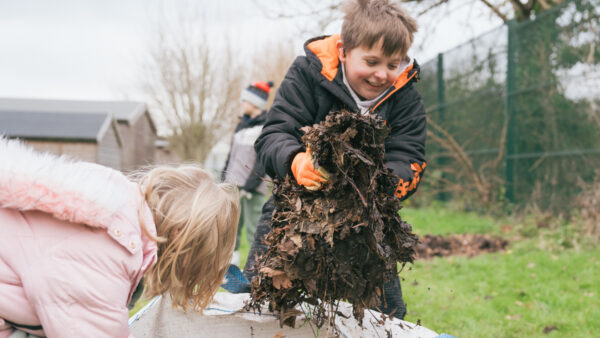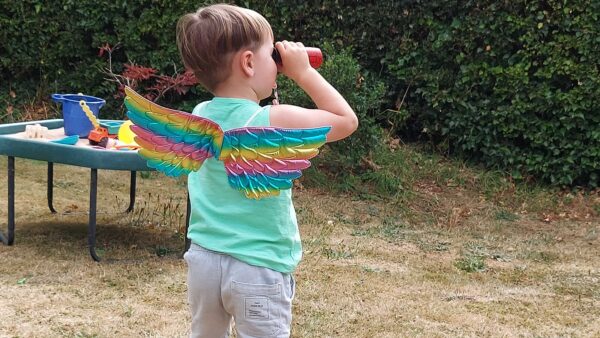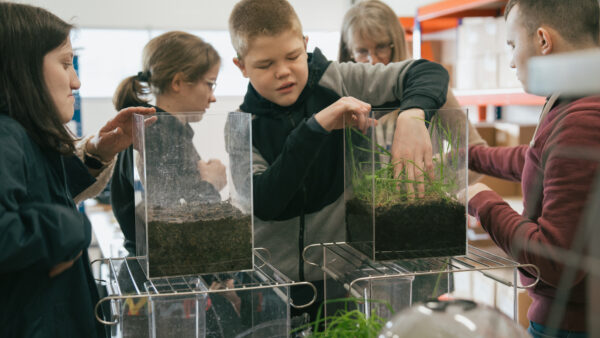How can we make climate action accessible and compelling?
What does a room full of people who are enthralled in something sound like? It's hard to describe… a gentle hubbub mixed with moments of "oh wow" and some laughter added in. We know it when we hear and see it, and it blows us away every time we do.
This is how students with sensory impairments reacted to a Collective Climate Repair workshop.
We knew that if we wanted to get honest feedback and really reach the people who will make a difference in the future, we just had to connect with St Vincent’s. St Vincent's school in Liverpool is a school for young people with sensory impairments. They are education leaders, supporting their students to become change-makers in today’s world, encouraged to be inquisitive, to learn, to build confidence. And it shows. The students’ comments bypass the trivial and get to the heart of the matter.
“If I'd thought about it before, it would have made sense, but the simplicity of seeing it has been so surprising"
A student from St Vincent's school


What is a climate repair workshop?
It’s a hands-on sensory experience packed with practical demonstrations to engage and inspire people to take climate action.
Heat lamps sit above trays of grass and soil, open-top bags display different mulch materials and transparent square containers are suspended above trays. Through their simplicity and ordinariness, they do what we hoped they would - they inspire people to be curious, to want to know more, to see what happens when they interact with them. The beauty of these workshops is that they rely on hands-on participation. It’s magical to see how people experience real-time cause and effect, and we believe that is why they work so well. It’s when people learn for themselves, by sight, touch and sound, witnessing in real time with real things, that they gain the greatest understanding.


Testing these techniques with a diversity of people has been key to creating demos that work well for everyone. As part of the early testing, iSight Cornwall organised a visit from a great group of people living with sight loss. Along with people who are neurodivergent, Deaf and hard of hearing, all the interactions and feedback have informed the demo designs that we now use.

What do the demos show us about climate repair?
The demos are designed to show how plants and nature are our biggest allies in repairing our climate and biodiversity. They are doing it every day, they have the answers and we can work with them to make effective change. Often we overlook the most obvious and simplest answers, and nowhere is this truer than with the nature we encounter every day.
The ‘slowing the flow’ demo is simple and perhaps because of that it has proved to be one of our most effective. Two transparent boxes are half-filled with the same soil: one is left bare while the other has long grass growing in it. Both have drainage holes in the bottom and a tube sticking out the front in line with the soil surface so water can escape as runoff.

The simple action of ‘being the raincloud’ and watering from above sends a steady downpour of water into the tanks and the effects are quick. The water in the bare soil builds up on the surface and starts pouring out of the tube, demonstrating the problem with water running off bare land in a flood. Conversely, in the grass tank, none of the water comes out of the tube and instead drips slowly from the holes underneath, demonstrating that the water is where we and the plants need it to be, in the ground rather than causing flooding.
This demo connects with what we see in the news almost daily, with stories of floods causing havoc around the world. It demonstrates how plants offer natural solutions to floods and calls on us to not only plant more but also look after the plants already here.
Why is climate repair important?
Dramatic climate events, from floods to droughts and fires, have become daily news features from around the world. But while the drama gets the headlines, we hear less about potential actions beyond big scale initiatives. Many of us are looking for things we can do.
The power of collective climate repair
Collective Climate Repair is about action we can all take. The floods and droughts remind us that water is a sign of climate chaos but the good news is that water is also our solution. Exciting new climate science shows how slowing and calming the water cycle is a route to climate action that we can all be part of.
All plants, even the tiniest ones, are catching and calming the water so more of it goes where they and we need it, in the ground. Through transpiration they cool the air, and through shade they cool the ground. They are soil makers and energy users. They are climate repairers. We can be too.

Some top tips for climate repair
There are some simple actions you can take regardless of your space and budget, for example:
- Cover bare soil with mulch or plants to keep it cool and moist.
- Grow more plants, the more you have the more climate action they take.
- Grow plants in new places, in containers and on walls and fences.
- Grow areas of longer grass and flowers, they will create shade, catch the rain and increase biodiversity.
- Protect and plant trees, they will make shade, capture rain and carbon and cool the air.
Heat mapping is a great way of identifying where your hot spots are, it's fun too. This heat mapping guide will show you how, also available as a large print heat mapping guide.




